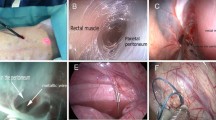Abstract.
Implantation of peritoneal dialysis catheters by traditional laparotomy or trocar/guidewire techniques leaves the operator blind to the actual location and configuration of the peritoneal catheter tubing; it is associated with drainage dysfunction from catheter obstruction in 10–22% of catheter placements. This report presents a laparoscopic technique that allows accurate tube placement with complete visualization of the implant procedure. The peritoneal dialysis catheter was implanted through a port inserted in a paramedian location. Videoscopic monitoring was performed through a second port inserted in a pararectus location on the opposite side of the abdomen. Nitrous oxide gas was utilized for peritoneal insufflation thus permitting the procedure to be accomplished under local anesthesia. Follow-up of ≤12.7 months (median, 4.4) for the first 28 patients revealed a high rate of successful catheter function with an outflow obstruction rate of 3.6%. The procedure was well tolerated by patients under local anesthesia on an outpatient basis. Videolaparoscopy is ideally suited for peritoneal dialysis catheter implantation. Visual conformation of proper catheter location and configuration during the implant process are associated with lower incidences of outflow failure.
Similar content being viewed by others
Author information
Authors and Affiliations
Additional information
Received: 7 November 1997/Accepted: 11 February 1998
Rights and permissions
About this article
Cite this article
Crabtree, J., Fishman, A. Videolaparoscopic implantation of long-term peritoneal dialysis catheters. Surg Endosc 13, 186–190 (1999). https://doi.org/10.1007/s004649900936
Published:
Issue Date:
DOI: https://doi.org/10.1007/s004649900936




